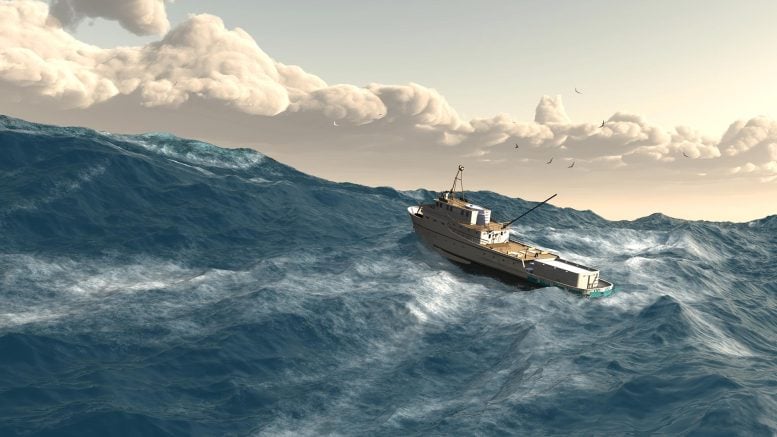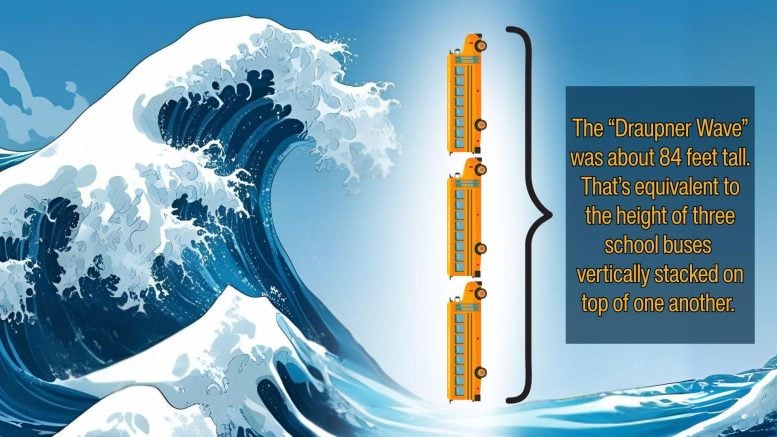
Rogue waves are not anomalies but the result of normal ocean dynamics. New data reveals they can be predicted.
On January 1, 1995, an enormous 80-foot wave struck the Draupner oil platform in the North Sea. The force of the wave bent steel railings and hurled heavy equipment across the deck, but its most significant effect was the evidence it provided. For the first time, scientists were able to record a rogue wave in the open ocean with precise measurements.
“It confirmed what seafarers had described for centuries,” said Francesco Fedele, associate professor Georgia Tech’s School of Civil and Environmental Engineering. “They always talked about these waves that appear suddenly and are very large — but for a long time, we thought this was just a myth.”
Rethinking Rogues
That single measured wave moved rogue waves out of the realm of myth and into science, sparking decades of debate about their origins.
Francesco Fedele, who had long questioned standard theories, led an international research team to explore how these massive waves truly form. Their study, published in Nature’s Scientific Reports, highlighted the importance of their conclusions. The group examined 27,500 wave records spanning 18 years in the North Sea, creating the most extensive dataset ever assembled on the subject.

Each record documented 30 minutes of detailed information, including wave height, frequency, and direction. The results overturned long-standing ideas, showing that rogue waves do not require unusual or “exotic” mechanisms to emerge—only the precise alignment of well-known ocean processes.
Fedele explained, “Rogue waves follow the natural orders of the ocean — not exceptions to them. This is the most definitive, real-world evidence to date.”
Extraordinary Waves, Ordinary Physics
The dominant theory about rogue wave formation has been a phenomenon called modulational instability, a process where small changes in timing and spacing between waves cause energy to concentrate into a single wave. Instead of staying evenly distributed, the wave pattern shifts, causing one wave to suddenly grow much larger than the rest.
Fedele pointed out that modulational instability “is mainly accurate when the waves are confined within channels, like in lab experiments, where energy can only flow in one direction. In the open ocean, though, energy can spread in multiple directions.”
A Deep Dive Into the Data
When Fedele and his colleagues examined the North Sea records, they found no indication that modulational instability played a role in rogue waves. Instead, they concluded that the largest waves arise from the interaction of two well-understood processes:
- Linear focusing — this occurs when waves moving at different speeds and directions meet at the same point in time and space, combining to create a crest much higher than normal.
- Second-order bound nonlinearities — natural effects that alter the shape of a wave, sharpening and raising the crest while flattening the trough. This distortion can amplify the height of large waves by 15–20%.
Fedele noted that when these two mechanisms coincide, they generate especially powerful waves. The inherently nonlinear character of ocean motion adds another layer of amplification, driving the waves to grow even larger.
From Failure to Forecast
Fedele stressed that this research has real-world urgency. Rogue waves aren’t just theoretical, they are real, powerful, and a danger to ships and offshore structures. Fedele said many forecasting models still treat rogue waves as unpredictable flukes. “They’re extreme, but they’re explainable,” he said.
Updating those models, he added, is critical. “It’s fundamental for the safety of ship navigation, coastal structures, and oil platforms,” Fedele explained. “They have to be designed to endure these extreme events.”
Fedele’s research is already informing how others think about ocean risk. The National Oceanic and Atmospheric Administration and energy company Chevron use his models to forecast when and where rogue waves are most likely to strike.
Fedele is now using machine learning to comb through decades of wave data, training algorithms to detect the subtle combinations — height, direction, timing — that precede extreme waves. The goal is to give forecasters more accurate tools that predict when a rogue wave could strike.
The lesson from this study is simple: Rogue waves aren’t exceptions to the rules — they’re the result of them. Nature doesn’t need to break its own laws to surprise us. It just needs time, and a rare moment where everything lines up just wrong.
Although ocean waves may seem random, extreme waves like rogues follow a natural recognizable pattern. Each rogue wave carries a kind of “fingerprint” — a structured wave group before and after the peak that reveals how it formed.
“Rogue waves are, simply, a bad day at sea,” Fedele said. “They are extreme events, but they’re part of the ocean’s language. We’re just finally learning how to listen.”
Reference: “Effects of bound-wave asymmetry on North Sea rogue waves” by Sagi Knobler, Mika P. Malila, M. Aziz Tayfun, Dan Liberzon and Francesco Fedele, 1 July 2025, Scientific Reports.
DOI: 10.1038/s41598-025-07156-6
Never miss a breakthrough: Join the SciTechDaily newsletter.
4 Comments
Do you know what? Ductility?
“Linear focusing — this occurs when waves moving at different speeds and directions meet at the same point in time and space, combining to create a crest much higher than normal.
I learned this as “constructive interference” where the amplitudes of two or more waves add.
I think it’s just Vegeta powering up.
As an ocean side Commoner I have watched, counted waves at coastlines in around North America and the general Caribbean.
Long ago we saw rythms and contradictions.
But this was not scientific.
It a comfort to understand that science is involved as these energetic movements of water may grow even larger by the cause of temperature increases and pollution throughout the planets estuaries.
Oceans are river unto themselves.